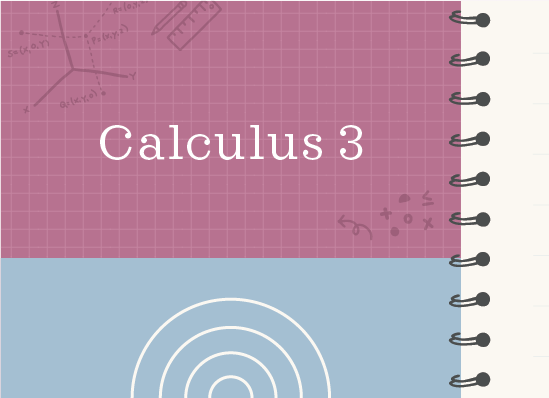Finding surface area of one function, bounded by another function, using a double integrals
You’re able to find the surface area of a figure using a double integral
Most often with these kinds of surface area problems, we’ll be asked to find the surface area of “the part of function A that lies inside function B”.
When this is the case, let’s think about the function that’s “inside” as the primary function, and the function that’s “outside” as the secondary function.
Hi! I'm krista.
I create online courses to help you rock your math class. Read more.
To find surface area of the primary, multivariable function, we can use the formula
???A(s)=\int\int_D\sqrt{1+\left(\frac{\partial{z}}{\partial{x}}\right)^2+\left(\frac{\partial{z}}{\partial{y}}\right)^2}dA???
where ???D??? represents the secondary function and ???\partial{z}/\partial{x}??? and ???\partial{z}/\partial{y}??? are partial derivatives of the primary function. Whether we integrate first with respect to ???x??? or first with respect to ???y??? depends on the object ???D???.
Video example of how to find the surface area using a double integral
Take the course
Want to learn more about Calculus 3? I have a step-by-step course for that. :)
Surface area of the part of the curve that lies inside a circle
Example
Find the surface area of the part of ???z=xy??? that lies inside ???x^2+y^2=4???.
Because we want to find the surface area of the part of ???z=xy??? that’s inside ???x^2+y^2=4???, we’ll call ???z=xy??? the primary function and ???x^2+y^2=4??? the secondary function.
Then we’ll find first-order partial derivatives of the primary function, ???z=xy???.
???\frac{\partial{z}}{\partial{x}}=y???
???\frac{\partial{z}}{\partial{y}}=x???
We need to figure out if the region we’re interested in is type I or type II. Since the region for which we’re finding surface area is defined by the secondary function ???x^2+y^2=4???, and this is a simple circle, we can treat the region as type I. We could choose either order, but we’ll decide to integrate first with respect to ???y??? and then ???x???, which means that so far, the integral looks like
???A(s)=\int\int_D\sqrt{1+y^2+x^2}\ dy\ dx???
let’s think about the function that’s “inside” as the primary function, and the function that’s “outside” as the secondary function.
All we need now are the limits of integration, which will come from ???x^2+y^2=4???. Solving this equation for ???y??? in terms of ???x??? in order to get limits of integration with respect to ???y??? gives
???x^2+y^2=4???
???y^2=4-x^2???
???y=\pm\sqrt{4-x^2}???
Remember, we had to find limits of integration for ???y??? with respect to ???x??? because we’re integrating first with respect to ???y???, and after we do, we need to have ???x??? variables left over so that we can then integrate with respect to ???x???. Now the integral is
???A(s)=\int\int^{\sqrt{4-x^2}}_{-\sqrt{4-x^2}}\sqrt{1+y^2+x^2}\ dy\ dx???
Next we can solve for the limits of integration with respect to ???x???. We want these limits to be constants so that, after we integrate with respect to ???x??? and evaluate over the interval, we end up with a constant for the surface area of the region. Since we’re looking for the surface area inside the circle with radius ???2???, we know that ???x??? is defined over the interval ???[-2,2]???. So the integral becomes
???A(s)=\int^2_{-2}\int^{\sqrt{4-x^2}}_{-\sqrt{4-x^2}}\sqrt{1+y^2+x^2}\ dy\ dx???
Now that we have all the pieces in place, we can work on solving the integral. The easiest way to solve it will be converting it to polar form. If we remember our conversion formulas, we know that ???r^2=x^2+y^2??? and that ???dy\ dx=r\ dr\ d\theta???. Making these substitutions gives
???A(s)=\int^{x=2}_{x=-2}\int^{y=\sqrt{4-x^2}}_{y=-\sqrt{4-x^2}}\sqrt{1+r^2}\ r\ dr\ d\theta???
Next we need to change the limits of integration into polar form. The limits on the inner integral need to match ???dr???, which means they have to be with respect to ???r???. Since we’re dealing with the circle centered at the origin with radius ???2???, ???r??? is defined over ???[0,2]???. So
???A(s)=\int^{x=2}_{x=-2}\int^{2}_{0}\sqrt{1+r^2}\ r\ dr\ d\theta???
The limits on the outer integral need to match ???d\theta???, which means they have to be with respect to ???\theta???. Since we’re dealing with the circle centered at the origin with radius ???2???, ???\theta??? is defined over ???[0,2\pi]???. So
???A(s)=\int^{2\pi}_{0}\int^{2}_{0}\sqrt{1+r^2}\ r\ dr\ d\theta???
To evaluate the resulting integral, we’ll use a u-substitution with
???u=1+r^2???
???du=2r\ dr???
???dr=\frac{du}{2r}???
Making these substitutions into the double integral gives
???A(s)=\int^{\theta=2\pi}_{\theta=0}\int^{r=2}_{r=0}\sqrt{u}\ r\left(\frac{du}{2r}\right)\ d\theta???
???A(s)=\int^{\theta=2\pi}_{\theta=0}\int^{r=2}_{r=0}\frac12\sqrt{u}\ du\ d\theta???
???A(s)=\int^{\theta=2\pi}_{\theta=0}\int^{r=2}_{r=0}\frac12u^\frac12\ du\ d\theta???
Integrate with respect to ???u???.
???A(s)=\int^{\theta=2\pi}_{\theta=0}\frac{1}{3}u^{\frac{3}{2}}\Big|^{r=2}_{r=0}\ d\theta???
Now, we can substitute back in for ???u??? using ???u=1+r^2???.
???A(s)=\int^{\theta=2\pi}_{\theta=0}\frac{1}{3}\left(1+r^2\right)^{\frac{3}{2}}\Big|^{r=2}_{r=0}\ d\theta???
Evaluate the inner integral.
???A(s)=\int^{2\pi}_0\frac{1}{3}\left[\left(1+2^2\right)^{\frac{3}{2}}-\left(1+0^2\right)^{\frac{3}{2}}\right]\ d\theta???
???A(s)=\int^{2\pi}_0\frac{1}{3}\left(5^{\frac{3}{2}}-1^{\frac{3}{2}}\right)\ d\theta???
???A(s)=\int^{2\pi}_0\frac{\sqrt{125}}{3}-\frac{1}{3}d\theta???
Integrate the outer integral.
???A(s)=\frac{\sqrt{125}}{3}\theta-\frac{1}{3}\theta\Big|^{2\pi}_0???
Evaluate the outer integral.
???A(s)=\bigg(\frac{\sqrt{125}}{3}(2\pi)-\frac{1}{3}(2\pi)\bigg)-\bigg(\frac{\sqrt{125}}{3}(0)-\frac{1}{3}(0)\bigg)???
???A(s)=\frac{2\pi\sqrt{125}}{3}-\frac{2\pi}{3}???
???A(s)=\frac{2\pi\sqrt{125}-2\pi}{3}???
???A(s)=\frac{2\pi}{3}\left(\sqrt{125}-1\right)???
???A(s)=\frac{2\pi}{3}\left(5\sqrt{5}-1\right)???
This is the surface area of the part of ???z=xy??? that lies inside ???x^2+y^2=4???.






